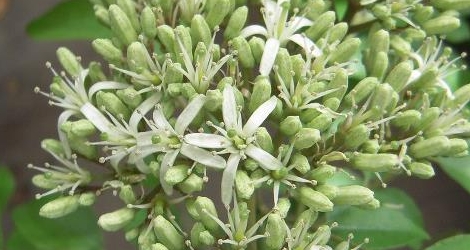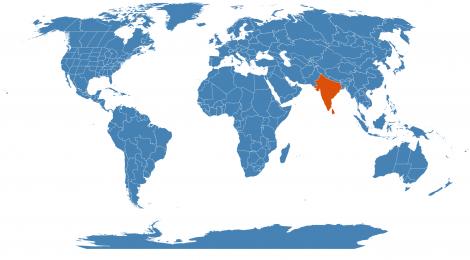Accession Data:
Murraya koenigii (L.) Sprengel
- Common Name: Curry Leaf Tree
- Family: Rutaceae Juss.
- Description: It is a small tree, growing 4-6 m (13-20 feet) tall, with a trunk up to 40 cm diameter. The leaves are petiole or axis; also applied to how the lateral veins are arranged in relation to the main vein.">pinnate, with 11-21 leaflets, each leaflet 2-4 cm long and 1-2 cm broad. They are highly aromatic. The flowers are small, white, and fragrant. The small black shiny berries are edible, but their seeds are poisonous.1
- Uses: The leaves are highly valued as seasoning in southern and west-coast Indian cooking, and Sri Lankan cooking especially in curries.1
In Ayurveda, "Eating curry leaves cooked in coconut oil leaves is recommended for healthy hair." (One World, 2001)
Because the curry leaves are rich in antioxidant, folic acid and iron, it is a great diet addition for those who suffer from anemia. They have also been used for those with diabetes and high cholesterol diseases.
Some other properties of this plant include treating inflammation, skin rashes, fighting parasites/worms, reducing vomiting and diarrhea as well as other digestive disorders.
In animal studies, the aim was to study the protective properties of curry leaves against lesions in the gastric intestines6. Results confirmed the antioxidant effects of this plant reduces free radicals which therefore prevent gastric stress.
- IMPORTANT NOTE: Plant Uses are for informational purposes only. EEB Greenhouses assume no responsibility for adverse effects from the use of any plants referred to on this site. Always seek advice from a professional before using any plant medicinally.
- Culture: Prefers slightly acidic soil and partial sun. Grow in well drained media, let dry lightly between watering.
- USDA Zone: 9a-11
Accession Data:
- Accession # 201200029
- Source: Marc Hachadorian - NYBG
- Accession Date: 05-25-2012
- Bench: 1219 - AUS:South Bench E
- Currently: active - healthy
- Qty: 2 confirmed on 10-05-2024
Classification:
- Division: Magnoliophyta
- Class: Magnoliopsida
- SubClass: eurosid II
- Order: Sapindales
- SubOrder:
- Family: Rutaceae
- SubFamily: Aurantioideae
- Tribe: Aurantieae
- SubTribe: Merrilliinae
Flowering Data:
This accession has been observed in bloom on:| Year | Jan | Feb | Mar | Apr | May | Jun | Jul | Aug | Sep | Oct | Nov | Dec | ||||||||||||||||||||||||||||||||||||||||
|---|---|---|---|---|---|---|---|---|---|---|---|---|---|---|---|---|---|---|---|---|---|---|---|---|---|---|---|---|---|---|---|---|---|---|---|---|---|---|---|---|---|---|---|---|---|---|---|---|---|---|---|---|
| 2024 | ||||||||||||||||||||||||||||||||||||||||||||||||||||
| 2023 | ||||||||||||||||||||||||||||||||||||||||||||||||||||
| 2022 | ||||||||||||||||||||||||||||||||||||||||||||||||||||
| 2021 | ||||||||||||||||||||||||||||||||||||||||||||||||||||
| 2020 | ||||||||||||||||||||||||||||||||||||||||||||||||||||
| 2019 | ||||||||||||||||||||||||||||||||||||||||||||||||||||
| 2018 | ||||||||||||||||||||||||||||||||||||||||||||||||||||
| 2017 | ||||||||||||||||||||||||||||||||||||||||||||||||||||
| 2016 | ||||||||||||||||||||||||||||||||||||||||||||||||||||
| 2015 | ||||||||||||||||||||||||||||||||||||||||||||||||||||
| 2014 | ||||||||||||||||||||||||||||||||||||||||||||||||||||
| 2013 | ||||||||||||||||||||||||||||||||||||||||||||||||||||
References (internal):
- Medicinal Plants - Ayurveda Medicine
- Spice Plants
- Medicinal Plants - Digestive System
- Medicinal Plants - Integumentary System
- Medicinal Plants - Immune System
References (external):
- Curry Tree at Wikipedia. Last accessed on Monday, July 24, 2017.
- The Plant List (2013). Version 1.1. Last accessed on Monday, July 24, 2017.
- Murraya koenigii. (2013, January 3). Wikispecies, . Retrieved 12:50, November 1, 2013
- The Global Biodiversity Information Facility: GBIF Backbone Taxonomy, 2013-07-01. Accessed on 2013-11-01
- Murraya koenigii at ARS-GRIN. Last accessed on Monday, July 24, 2017.
- S.B Firdaus, D. Ghosh,A. Chattyopadhyay, M.Dutta, S. Paul, J. Jana, A. Basu, G. Bose, H. Lahiri, B. Banerjee, S. Pattari, S. Chatterjee, K. Jana, and D. Bandyopadhyaya Protective effect of antioxidant rich aqueous curry leaf (Murraya koenigii) extract against gastro-toxic effects of piroxicam in male Wistar rats Toxicol Rep. 2014; 1: 987-1003. Pub. online 2014 Jul 2. Last accessed on Thursday, February 08, 2018.
- MURRAYA KOENIGII- CURRY TREE Last accessed on Thursday, February 08, 2018.
data regenerated on Tue, 08 Oct 2024 13:07:51 -0400 [bcm v4.0]
Images:

Additional images for this accession:
Click on thumbnails to enlargeCurrent Accessions in the Rutaceae
Subfamily Aurantioideae
Tribe Aurantieae
- Merrilliinae: Murraya koenigii


- Merrilliinae: Murraya paniculata

Subfamily Aurantioideae
Tribe Citreae
- Citrinae: Citropsis daweana

- Citrinae: Citrus aurantiifolia


- Citrinae: Citrus japonica Nagami

- Citrinae: Citrus junos
- Citrinae: Citrus x limon

- Citrinae: Citrus medica


- Citrinae: Citrus x pyriformis
- Citrinae: Citrus reticulata


- Citrinae: Citrus reticulata Clementine de Nules
- Citrinae: Citrus trifoliata
- Triphasiinae: Triphasia trifolia
Subfamily Rutoideae
Tribe Ruteae
Subfamily Spathelioideae
Subfamily Toddalioideae
W/C = Wild Collected = indicates flowering in past 14 days
= indicates flowering in past 14 days
 = images available for this accession
= images available for this accession
 = map available for this accession
= map available for this accession
 = accession added within past 90 days
= accession added within past 90 days

